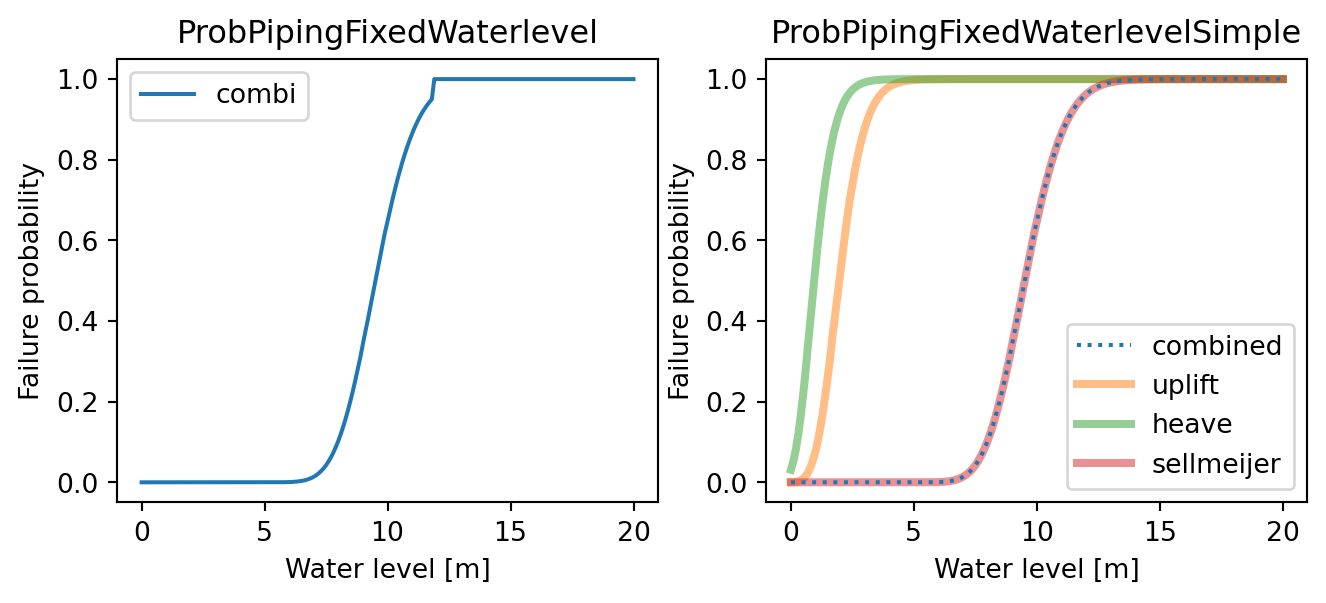from pathlib import Path
import pandas as pd
import matplotlib.pyplot as plt
from probabilistic_piping import (
ProbInput,
ProbPipingFixedWaterlevel,
ProbPipingFixedWaterlevelSimple,
)Fixed water level application
The package contains two classes for fixed water level calculations: ProbPipingFixedWaterlevel and ProbPipingFixedWaterlevelSimple. These two classes both have methods calculating a single failure probability given a water level (fixed_waterlevel_failureprobability()), or for a range of water levels (fixed_waterlevel_fragilitycurve()).
The ProbPipingFixedWaterlevelSimple class calculates the three submechanisms of piping (heave, uplift, sellmeijer) separately and combines the failure probabilities of the submechanisms to a combined failure probability (by taking the minimum failure probability of the three submechanims). This is somewhat different than the combi mechanism of ProbPipingFixedWaterlevel, where the minimum of the three submechanisms is taken in the limit state function.
The moniker ‘Simple’ has been added to ProbPipingFixedWaterlevelSimple because taking the minimum of the failure probabilities of the submechanims is seen as a simplified approach.
In this notebook, a comparison of the two approaches is shown.
Input
The same input data as in the introduction is used and converted to the required ProbInput format.
data_path = Path("../../../test/data/full_test.xlsx")
df_input = pd.read_excel(data_path, sheet_name="input", index_col=0, header=0)
inp_data = ProbInput.from_dataframe(df_input)ProbPipingFixedWaterlevel
First, we calculate the failure probability for the given input using the ProbPipingFixedWaterlevel class.
prob = ProbPipingFixedWaterlevel(progress=False)
_, pc = prob.fixed_waterlevel_fragilitycurve(inp_data, z_type="combi")ProbPipingFixedWaterlevelSimple
Then we calculate the failure probability using the ProbPipingFixedWaterlevelSimple class. Notice that this class returns four results: three submechanism results and one combined result.
prob_simple = ProbPipingFixedWaterlevelSimple(progress=False)
_, pu, ph, pp, pcs = prob_simple.fixed_waterlevel_fragilitycurve(inp_data)Visualize
We can now visually compare the results of the two approaches. The results are subtly different, but overal comparable.
fig, (ax1, ax2) = plt.subplots(ncols=2, figsize=(8, 3))
ax1.set_title("ProbPipingFixedWaterlevel")
ax1.plot([r.h for r in pc.results], [r.prob_cond for r in pc.results], label="combi")
ax1.set_xlabel("Water level [m]")
ax1.set_ylabel("Failure probability")
ax1.legend()
wl = [r.h for r in pcs.results]
ax2.set_title("ProbPipingFixedWaterlevelSimple")
ax2.plot(wl, [r.prob_cond for r in pcs.results], label="combined", ls=":", zorder=10)
ax2.plot(wl, [r.prob_cond for r in pu.results], label="uplift", lw=3, alpha=0.5)
ax2.plot(wl, [r.prob_cond for r in ph.results], label="heave", lw=3, alpha=0.5)
ax2.plot(wl, [r.prob_cond for r in pp.results], label="sellmeijer", lw=3, alpha=0.5)
ax2.set_xlabel("Water level [m]")
ax2.set_ylabel("Failure probability")
ax2.legend();